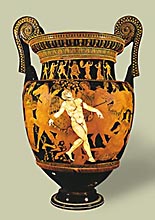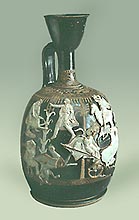

Two important early |
 |
 | Of the many potters working in this period we can single out for mention Xenophantus (who signs himself 'Athenian'). It was he who decorated a large squat lekythos from Kerch with figures in bas-relief. This use of relief on pots is obviously inspired by the metal vessels with repousse work that were so fashionable at this time. The Kerch style. Some fifty years before Attic red-figure pottery came to an end, a style that has been named after the Crimean city of Kerch made its debut. Kerch is the classical Panticapaeum, and many pots of this type have been discovered there. (The Kerch style died with red-figure pottery itself). The shapes most commonly found are the pelike, the lekanis, the lebes gamikos, and the krater. As for the subjects, they generally have to do with mythological beings popular among the peoples of the Black Sea: for instance, griffins, Arimaspians, and Amazons. |
The
The red-figure style of Athenian pottery effectively ends in about
 |
 |
|
| |
|||
| |||